
The okapi, also known as the forest giraffe, Congolese giraffe and zebra giraffe, is an artiodactyl mammal that is endemic to the northeast Democratic Republic of the Congo in central Africa. However, non-invasive genetic identification has suggested that a population has occurred south-west of the Congo River as well. It is the only species in the genus Okapia. Although the okapi has striped markings reminiscent of zebras, it is most closely related to the giraffe. The okapi and the giraffe are the only living members of the family Giraffidae.

Chelidae is one of three living families of the turtle suborder Pleurodira, and are commonly called Austro-South American side-neck turtles. The family is distributed in Australia, New Guinea, parts of Indonesia, and throughout most of South America. It is a large family of turtles with a significant fossil history dating back to the Cretaceous. The family is entirely Gondwanan in origin, with no members found outside Gondwana, either in the present day or as a fossil.
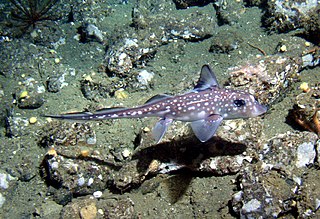
Chimaeras are cartilaginous fish in the order Chimaeriformes, known informally as ghost sharks, rat fish, spookfish, or rabbit fish; the last three names are not to be confused with rattails, Opisthoproctidae, or Siganidae, respectively.
The false stag beetles (Diphyllostoma) are a group of three species of rare beetles known only from California. Almost nothing is known of their life history beyond that the adults are diurnal and females are flightless; larvae have not been observed.
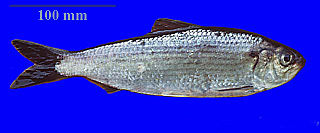
The alewife is an anadromous species of herring found in North America. It is one of the "typical" North American shads, attributed to the subgenus Pomolobus of the genus Alosa. As an adult it is a marine species found in the northern West Atlantic Ocean, moving into estuaries before swimming upstream to breed in freshwater habitats, but some populations live entirely in fresh water. It is best known for its invasion of the Great Lakes by using the Welland Canal to bypass Niagara Falls. Here, its population surged, peaking between the 1950s and 1980s to the detriment of many native species of fish. In an effort to control it biologically, Pacific salmon were introduced, only partially successfully. As a marine fish, the alewife is a US National Marine Fisheries Service "Species of Concern".

The Drosophilidae are a diverse, cosmopolitan family of flies, which includes species called fruit flies, although they are more accurately referred to as vinegar or pomace flies. Another distantly related family of flies, Tephritidae, are true fruit flies because they are frugivorous, and include apple maggot flies and many pests. The best known species of the Drosophilidae is Drosophila melanogaster, within the genus Drosophila, also called the "fruit fly." Drosophila melanogaster is used extensively for studies concerning genetics, development, physiology, ecology and behaviour. Many fundamental biological mechanisms were discovered first in D. melanogaster. The fruit fly is mostly composed of post-mitotic cells, has a very short lifespan, and shows gradual aging. As in other species, temperature influences the life history of the animal. Several genes have been identified that can be manipulated to extend the lifespan of these insects. Additionally, Drosophila subobscura, also within the genus Drosophila, has been reputed as a model organism for evolutionary-biological studies, along with D. sechellia for the evolution of host specialization on the toxic noni fruit and Scaptomyza flava for the evolution of herbivory and specialist on toxic mustard leaves.

Sand sharks, also known as sand tiger sharks, gray nurse sharks or ragged tooth sharks, are mackerel sharks of the family Odontaspididae. They are found worldwide in temperate and tropical waters. The three species are in two genera.

Mesostigmata is an order of mites belonging to the Parasitiformes. They are by far the largest group of Parasitiformes, with over 8,000 species in 130 families. Mesostigmata includes parasitic as well as free-living and predatory forms. They can be recognized by the single pair of spiracles positioned laterally on the body.
Nephelomys keaysi, also known as Keays's oryzomys or Keays's rice rat, is a species of rodent in the genus Nephelomys of family Cricetidae. It is found from southeastern Peru to northern Bolivia on the eastern slope of the Andes in Yungas humid forest at altitudes of 1000 to 2600 m. Although its continued existence is not in serious danger and it is listed as "least concern", destruction of its habitat may pose a threat to some populations.
Arctodiaptomus is a genus of copepods in the family Diaptomidae.

Carp's tit or Carp's black tit, is a species of bird in the family Paridae. Some authors consider it a subspecies of the black tit. It is found throughout the Namibian savanna woodlands and the southern Angolan mopane woodlands.

Onchiodon is an extinct genus of temnospondyl. It is primarily known from the Carboniferous and Permian of Europe, but also from the Permian of North America. It was an amphibious carnivore.

Tarantulas comprise a group of large and often hairy spiders of the family Theraphosidae. As of December 2023, 1,100 species have been identified, with 166 genera. The term "tarantula" is usually used to describe members of the family Theraphosidae, although many other members of the same infraorder (Mygalomorphae) are commonly referred to as "tarantulas" or "false tarantulas". Some of the more common species have become popular in the exotic pet trade. Many New World species kept as pets have setae known as urticating hairs that can cause irritation to the skin, and in extreme cases, cause damage to the eyes.
Centropagidae is a family of copepods in the order Calanoida. Its members are particularly known as plankton in coastal waters and in fresh water in Australia and southern South America. They are also found on subantarctic islands and in lakes in Antarctica.
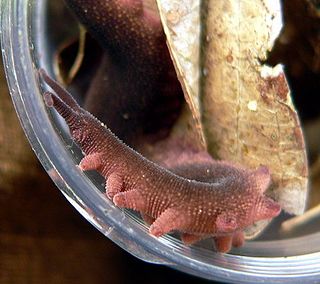
Eoperipatus is a Southeast Asian genus of velvet worm in the family Peripatidae. The number of legs in this genus varies within species as well as among species and ranges from 22 pairs to 25 pairs. This genus exhibits lecithotrophic ovoviviparity; that is, mothers in this genus retain yolky eggs in their uteri.

Carabinae is a subfamily of ground beetles in the family Carabidae. There are about 10 genera and more than 1,400 described species in Carabinae.
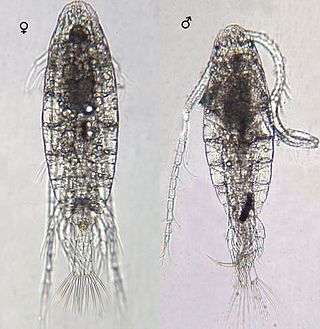
Leptodiaptomus ashlandi is a calanoid copepod zooplankton native to the Laurentian Great Lakes and their basin.
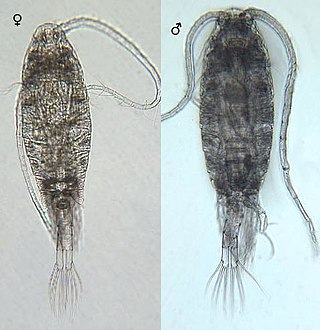
Leptodiaptomus sicilis is a calanoid copepod native to the Laurentian Great Lakes and its basin.
Limnocalanus macrurus is a species of crustacean belonging to the family Centropagidae.

Genettinae is a subfamily of the feliform viverrids. It contains all of the genet species and the oyan species.














